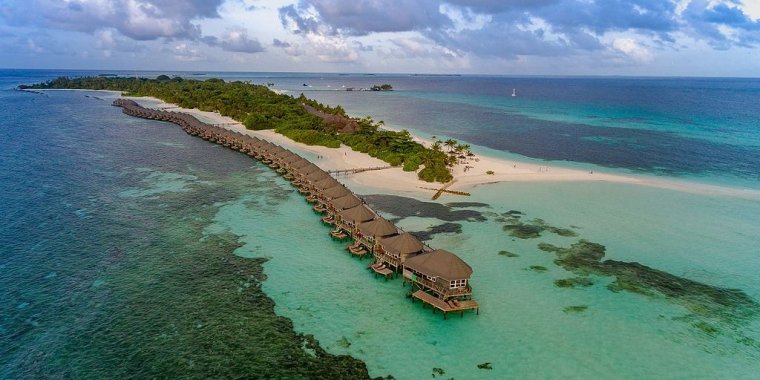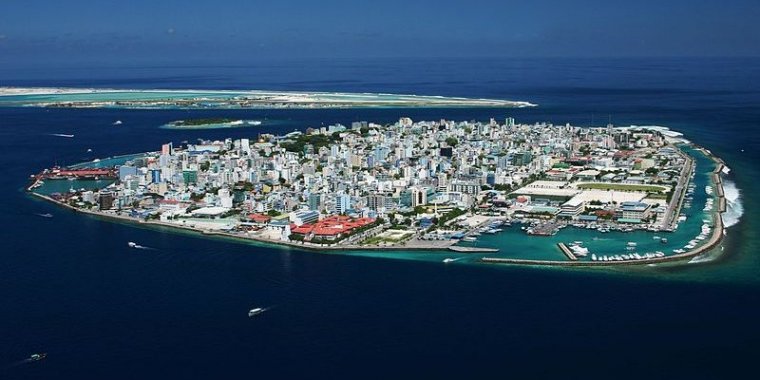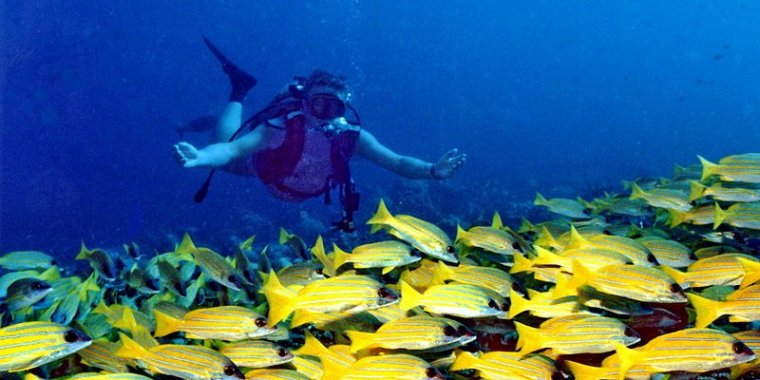| Published in Destinations |
Maldives
The Maldives are formed of 26 atolls. These are not single islands, but giant ringlike coral formations hundreds of kilometres wide that have fragmented into countless islands. Of the 20 administrative atoll groups, only (parts of) 10 are open to tourism, and from north to south these are:
• Lhaviyani (Miladhunmadulu Uthuruburi).
• Raa (Maalhosmadulu Uthuruburi).
• Baa (Maalhosmadulu Dhekunuburi).
• Kaafu (North and South Malé Atoll). Site of the capital Malé and the airport, home of most Maldivian resorts.
• Alifu (Ari). To the west of Kaafu, the second most popular group.
• Vaavu (Felidhu).
• Meemu (Mulak).
• Faafu (Nilandhe Atholhu Uthuruburi).
• Dhaalu (Nilandhe Atholhu Dhekunuburi).
• Seenu (Addu). The southernmost atoll, the second-largest in population and site of Gan International Airport.
The other atolls are Gaafu Alifu, Gaafu Dhaalu, Gnaviyani, Haa Alifu, Noonu, Haa Dhaalu, Laamu, Nyavinani, Seenu, Shaviyani, and Thaa.
Cities
• Malé — the capital and largest city.
• Seenu — second-largest city and short-lived home of the Suvadive secessionist movement.
Other destinations
• Kuredu — one of the inhabited islands of Lhaviyani Atoll.
• Mathiveri — island belonging to North Ari Atoll.
• Rasdhoo — smallish inhabited island and the capital of the North Ari Atoll.
• Thoddoo — an isolated inhabited island that administratively belongs to North Ari Atoll. It's also the largest producer of watermelon in Maldives.
• Ukulhas — smallish 1 km long island of Alif Alif Atoll.
Climate
The Maldives are tropical, with plenty of sunshine and temperatures around 30°C (86°F) throughout the year. However, rainfall increases considerably during the April-October southwest monsoon, particularly from June to August.
Get in
The Maldives have a remarkably easy visa policy. Everybody gets a free 30-day visa on arrival, provided that they have a valid travel document, a ticket out and proof of sufficient funds, defined as either a confirmed reservation in any resort or US$25/day in cash. This can be extended up to 90 days at Malé, but you'll need to indicate where you're staying for that long.
The Maldives is an Islamic country. Importing the following is prohibited: Alcohol, pork and pork by-products, religious articles other than Islamic ones, narcotics and psychotropic drugs, pornography. All luggage is X-rayed on arrival. Exporting sand, seashells or coral is also forbidden.
• By plane. Practically all visitors arrive at Malé International Airport (MLE), located on Hulhulé Island right next to the capital Malé. The airport is served by a wide array of flights to China, India, Sri Lanka, Dubai and major airports in South-East Asia, as well as an increasing number of charters from Europe. Many flights stop in Colombo (Sri Lanka) on the way. Gan Airport (GAN), on the southern atoll of Addu, also serves an international flight to Milan several times a week.
Departure taxes are included in your ticket.
British Airways now flies directly from London Gatwick to Malé during the winter (October to March). No direct flights operate from London Heathrow, however it is possible to get an indirect flight via India or the UAE for example. Singapore Airlines flies daily direct from Singapore to Malé, with late night timings.
• By boat. There are no regular passenger boats to the Maldives. Even yachts usually steer clear, as navigating around the reefs is hazardous and permits are expensive.
Get around
Getting around in the Maldives takes three forms: boats, sea planes (air taxis) and private yachts. The boats are the Maldivian equivalent of a car, while planes and private yachts are mainly reserved for tourists.
Air taxis and boats prefer not to operate at night, so if you arrive at the airport after dark and are going to a distant resort, you may have to spend the night in Malé or at the airport hotel in Hulhule. Private transfers, though expensive can be opted for resort transfers, instead of spending the whole night at Malé. Private transfers could cost US$500-800. On the way back, there may also be a significant gap between the time your transfer arrives and your flight departure. Check with your resort or travel agent.
• By plane. No point in the Maldives is more than 90 minutes away by plane from Malé, and visitors to the more far-flung resorts use air taxi services. As of 2013, the only operator is Trans Maldivian Airways, which flies DHC-6 Twin Otter seaplanes that take around 15 passengers.
Scheduled inter-island services are provided by Island Aviation, which flies from Malé to Gan, Hanimaadhoo, Kaadeddhoo and Kaddhoo. Travel permits are no longer required.
• By boat. The taxi boats generally take tourists to and from the islands in the North and South Malé atolls. They come in all different shapes and sizes depending on the quality of the resort you stay in — the Four Seasons has a large enclosed motor cruiser with drinks and food, while the lesser resorts have open sided dhoni fishing boats.
Public dhoni ferries and cargo boats are available for more independent-minded and budget-conscious travellers. The main operator is MTCC, who list schedules and fares on their website.
The previous system of requiring written invitations and Inter Atoll Travelling Permits (IATP) for travellers wishing to visit other islands has been abolished, you're now free to travel wherever you wish. IATPs are still required if you wish to dock your own yacht, see Customs for details.
Talk
Maldivian Dhivehi, a close relative of Sinhala (spoken in Sri Lanka) but with borrowings from Urdu, Hindi, Arabic and many other languages, is the official language. It is written in a remarkable hybrid script called Thaana, which uses Arabic and Indic numbers as the base of the alphabet, written from right to left with Arabic vowel signs.
The script is thought to have originated as a secret code for writing magical formulas so that outsiders can't read them, which would also explain why the ordering of the alphabet is, as far as linguists can tell, completely random.
English is widely spoken, particularly by government officials and those working in the tourism industry. English is also the language of instruction in schools.
Since Maldives are a a popular destination for German and Italian holiday makers, a sizeable number of local resort workers speak German and Italian. This may vary depending between resorts.
What to See in Maldives
• Most visitors come to enjoy the countless plush resorts, excellent beaches and stunningly colourful underwater life. Due to the isolated position of the island, the number of animals on land is limited, but just under the surface of the beautiful blue ocean there's a wealth of wildlife to see.
• Over 2000 species of fish in all colours of the rainbow roam the clear waters around the islands. You will likely see plenty of anemones, different kinds of rays, octopus, squid and even giant clams. Whales, dolphins and turtles are spotted often.
• The Baa Atoll, named a UNESCO World Biosphere Reserve in 2011 and one of the richest coral reefs in the world, is becoming a main tourist draw while also becoming an example of sustainable tourism in a protected area.
• The gorgeous and ubiquitous white sand beaches are a sight by themselves, especially with the tropical island setting they are in. A flight to one of the many resort islands gives spectacular aerial views of these picture-perfect islets, defined by rims of white sand and wide strokes of cobalt blue water.
• The capital Malé is a pleasant diversion. The bustling financial and political centre of the country has a few sights.
• Try the National Museum for a touch of history. While the building may not look too promising, the museum's fine collection includes beautiful Arabic- and Thaana-engraved wood works, religious pieces, weaponry and other historic artefacts.
• The town also has a number of worthwhile mosques. The 17th century Old Friday Mosque is the oldest one in the country, and officials are often willing to let polite and properly dressed visitors in. The Grand Friday Mosque & Islamic Centre is its 1984 modern counterpart, and dominates the city's skyline. While simply in design, the large, white marble structure and shining gold dome is an attractive sight.
What to Do in Maldives
• Diving and snorkelling. Aside from making the water bungalow rock on your honeymoon, the primary activity on the Maldives is scuba diving. The atolls are all coral reefs hundreds of kilometres away from any major land mass, meaning that water clarity is excellent and underwater life is abundant. Manta rays, sharks, even a few wrecks, you name it, you can find it in the Maldives.
While diving is very good by world standards even in the immediate vicinity of Malé, visibility and the chance of encountering large pelagic fish increases as you head to the outer atolls. Many divers opt for live-aboards, which can actually work out much cheaper than paying high resort fees.
Currents vary considerably, with generally little inside the atolls but some powerful streams to be found on the sides facing the open sea. Water in the Maldives is warm throughout the year and a 3 mm shorty or Lycra diveskin is plenty.
Diving is possible throughout the year, but rain, wind and waves are most common during the season of the southwest monsoon (June-August). The best time for scuba diving is from January to April, when the sea is calm, the sun is shining and the visibility can reach 30 m. There are decompression chambers on Bandos in Kaafu (15min from Malé), Kuredu in Lhaviyani Atoll and at Kuramathi on Alifu.
The one downside to diving in the Maldives is that it's quite expensive by Asian standards. Prices vary considerably from resort to resort, with specialist dive resorts offering better prices. In general, a single boat dive with your own gear cost around US$50, and US$75 without. Beware of surcharges: you may be charged extra for boat use, guided dives, larger tanks, etc.
On the upside, safety standards are usually very high, with well-maintained gear and strict adherence to protocol (check dives, maximum depth, computer use, etc.) being the rule rather than the exception.
• Surfing. The Maldives is becoming an increasingly popular surfing destination. Turquoise water and perfect waves makes it an ideal and un-crowded destination for surfers looking for smooth surfing conditions.
The best period for surfing in the Maldives is between March and October; the biggest waves occurring in June, July and August. This paradise is exposed to the same swells as Indonesia is, except that its higher latitude and its South-East exposure offers cooler and less hardcore surfing.
The recent O’Neil Deep Blue Contests held in the Maldives has placed Maldives firmly on the world’s surf map. While most of the recognized surf breaks are in Malé’ Atoll, there is certainly more to be discovered.
Specialized companies organize tailored multi-day boat trips in the region, allowing surfers to move easily from one point to another and maximizing the surfing time.
Buy
• Money. The local currency is the Maldivian rufiyaa, denoted by the symbol "Rf" or "MFR" (ISO code: MVR). It is divided into 100 laari. However by law, resorts price services in US dollars and require payment in hard currency (or credit card), so there's absolutely no need to change money if you're going to spend all your time at the resorts.
Most hotels have a shop but this is limited to diving and holiday essentials (sun cream, sarongs, disposable cameras, etc.) Some excursions from resorts will take you to local islands where there are handicraft type things to buy, but they are typically made outside the Maldives and sold at outrageous markups.
If you are heading to Malé or the other inhabited atolls, exchanging some rufiyaa will come in handy. The coins, in particular, are quite attractive and make an interesting souvenir in themselves, but the smaller denominations are rarely used or seen.
The rufiyaa is tied to the US dollar with in a 20% band, but is practically 15:1. Dollars are near-universally accepted: shops usually exchange them at 15:1 or 10:1.
• Tipping. Tipping is not compulsory in the Maldives as 10% service charge is added to everything - but given the low salaries earned by the staff and the excellent level of service generally offered, it is a nice gesture to help the staff of resorts to earn some extra money. It is also not entirely certain that the 10% service charge is passed on to the staff.
Over the years the tipping culture has changed in the Maldives, mainly due to Europeans and visitors from other continents giving varying amounts of cash as tips.
• Costs. Maldives are expensive for those who have comfort- and service-oriented tourism in mind. Resorts have a monopoly on services for their guests and charge accordingly: for mid-range resorts, €942 (US$1000) per week per couple is a conservative budget for meals, drinks and excursions, in addition to the cost of flights and accommodation. Practically anything — including hotel rooms if booked locally — gets slapped with an arbitrary 10% "service charge", but tips are expected on top.
For an adventurous traveller who has time, Maldives can be a very affordable and rewarding experience, with prices comparable to Malaysia. A number of inhabited islands have guesthouses with typical prices €25-40 (US$26.50-$42.48) per room. On more remote islands, renting rooms in villages is possible at even less than that. Food is inexpensive (and fish curries are delicious).
Public ferries will transfer you between different islands of the same atoll for a few US dollars (though for less obvious locations, there will typically be 1 ferry per day and no ferries on Fridays). For transfers to remote atolls, one can negotiate with cargo boats, which would often take people for €14-38(US$15-40), depending on the destination. Cargo boats do not have schedules and depart when loaded. One may expect 1 boat in 1-3 days for each atoll.
It is important to have in mind that staying on inhabited islands implies respecting the strict Muslim norms including no alcohol, modest dress, reserved behaviour. However, the locals are very welcoming and the experience may be much deeper and more rewarding than staying in resorts.
Eat
All the resorts are self-contained so they have at least one restaurant, which generally serve the type of cuisine expected by their guests (i.e. modern European or generic Asian). Breakfast is almost always included, and most resorts offer the option of half-board, which means you get a dinner buffet, and full board, which means you get a lunch and dinner buffet.
These can limit the damage compared to ordering a la carte, but your options are typically very limited and drinks are often not covered, not necessarily even water. If you're planning on drinking a lot, it may be worthwhile to go all inclusive, but even this typically restricts you to house drinks.
The only other place to find food is Malé. This comes in two forms. Either small restaurants aimed at the tourists (of which there are a couple of nice Thai restaurants), which are often expensive, or small cafes called hotaa, selling local Maldivian food at prices as low as Rf20 (US$6) for a complete meal.
Maldivian food revolves largely around fish (mas), in particular tuna (kandu mas), and draws heavily from the Sri Lankan and south Indian tradition, especially Kerala. Dishes are often hot, spicy and flavoured with coconut, but use very few vegetables.
A traditional meal consists of rice, a clear fish broth called garudhiya and side dishes of lime, chili and onions. Curries known as riha are also popular and the rice is often supplemented with roshi, unleavened bread akin to Indian roti, and papadhu, the Maldivian version of crispy Indian poppadums. Some other common dishes include:
— mas huni — shredded smoked fish with grated coconuts and onions, the most common Maldivian breakfast.
— fihunu mas — barbequed fish basted with chili.
— bambukeylu hiti — breadfruit curry.
Snacks called hedhikaa, almost invariably fish-based and deep-fried, can be found in any Maldivian restaurant.
— bajiya — pastry stuffed with fish, coconut and onions.
— gulha — pastry balls stuffed with smoked fish.
— keemia — deep-fried fish rolls.
— kulhi borkibaa — spicy fish cake.
— masroshi — mas huni wrapped in roshi bread and baked.
— theluli mas — fried fish with chili and garlic.
Drink
As the Maldives are Muslim, alcohol is banned for the local population. However, nearly all resorts, live-aboard boats and the Hulhule Island Hotel (on the same island as the airport) are licensed to serve it, usually with a steep markup. Expatriate residents have an allowance that they can use in Malé.
Maldivians generally do not drink alcohol although this is less true of the younger generation. They are, however, unhappy about being filmed or photographed while drinking.
Tap water in resorts may or may not be drinkable -- check with management. Bottled water is extortionately priced, with US$5/bottle being typical.
Sleep
The Maldives had a longstanding policy of keeping tourists on dedicated islands, which meant they could only stay in full-service resorts where the cost of a night's accommodation started around US$200 and went up into the stratosphere, and the vast majority of visitors continue to opt for these. However, the brief democratic blossoming under Mohammed Nasheed's rule from 2008 all the islands were opeed to tourism, and backpacker-friendly guesthouses starting from US$30 a night opened on inhabited islands across the archipelago.
Resorts
Most resorts take up their own island (1500 x 1500m to 250 x 250m), meaning that the ratio of beach to guests must be one of the best in the world and it is hard to imagine that you would ever have to struggle to find your own private piece of beach to relax on. Many have a "no shoes" policy and with such soft sands it is easy to love this idea.
The range and themes or the resorts is impressive, and most people will find one they like. Broadly speaking they can be grouped into three brackets:
• Dive resorts, designed primarily for divers. Geared expressly for people who want to spend most of their time underwater, facilities on land are limited, but the house reef is usually excellent. Often found in the more far-flung parts of the archipelago.
• Holiday resorts, designed primarily for families. These are large and have a full complement of facilities (several restaurants, day-care centres, etc.), but don't have over-the-top luxury and have less privacy. Most of these are located on Kaafu, with easy access from Malé.
• Luxury resorts, designed primarily for honeymooners and the jet set. The place to be if you want designer furniture, gourmet food and a plasma TV in an overwater villa reachable only by rowboat, and are willing to pay high prices for the privilege.
A Maldivian classic is the overwater bungalow, built on stilts directly above a lagoon. While these look fabulous and sound appealing, they have their downsides:
— They're usually packed tightly together (often sharing a wall), meaning little privacy.
— Especially at low tide, the water level may be too low to allow swimming or snorkelling.
— Resort facilities may be a fair distance from the bungalows.
— The lapping of waves is romantic enough on a calm day, but can make it next to impossible to sleep if a storm blows through.
These factors vary from resort to resort, so research carefully. A good one is definitely worth trying at least once, but many Maldives repeaters prefer a bungalow with a private beach.
When considering where to go, factor in transport time and costs from the airport: the more far-flung resorts generally require an expensive seaplane transfer and you may have to stay overnight at the airport on the way. On the upside, the further away you are from Malé, the more peaceful the islands and the better the diving.
Many resorts, especially the smaller dive-oriented ones, cater largely to a single nationality, leading to "Italian" resorts, "Dutch" resorts, "German" resorts, etc. While almost all welcome any nationality and have some English-speaking staff on hand, you may be cut off from any evening entertainment and have problems e.g. diving if you don't speak the local lingo.
Guesthouses
There are guesthouses on inhabited islands, and Maafushi island is popular with looking for hassle-free accommodation of this type. Low end prices are €25-35 per night. Examples include:
• Equator Village on Addu Atoll, a former British Royal Air Force base converted to a 78-room hotel. The cost is around US$100-150 per person per day all inclusive (includes regular brand alcohol).
• Keyodhoo Guest House, this guest house is on top of a recreation centre built by an Australian after the tsunami (US$20 pp/per night). Most visitors are scuba divers or adventure travellers.
• Other Inns/B&B can also be found on Vaavu Atoll, Dhaalu Atoll, Kaafu Atoll, North/South Malé Atoll and Ari Atoll Haggnaameedhoo. Only a few of these inns and B&Bs have their own pool. Confirm if bikinis are allowed on the beach. The distance between the inns and beaches are usually short, but visitors should still dress appropriately to Maldive customs.
Village homestays
More indepent-minded travellers and those looking for cultural experience may consider renting rooms in villages. This will require either walking through the village and asking around if you're particularly confident of your social skills, or inquiring in Malé whether someone can put you in contact with their friends or relatives on remote island for such an informal homestay. Prices can be as low as 15 euros per night for a clean functional room.
Stay safe
There is very little crime in the tourist resorts with their patrons often not venturing wider afield. Generally, Maldivians are honest, helpful and welcoming people although you are unlikely to come into much contact with them in resorts.
There are no drugs anywhere in the resorts but most Maldivians have easy access to drugs. Drug addiction is increasingly common and petty crime has been on the rise. Take the usual precautions such as not leaving money and valuables lying around. Note that every US$50 you spend at a bar or restaurant represents 10 days' wages for cleaners.
Cases of sexual harassment are not rare in Maldives. Solo female travellers should be vigilant, especially at the bikini beaches.
Stay healthy
There are no serious problems with diseases in the Maldives. Beware that tap water may not be drinkable at all resorts: enquire locally. The Maldives are malaria-free, but some islands do have mosquitoes and catching dengue fever from them is possible, albeit highly unlikely. For those coming from regions infected by yellow fever, an international certificate of inoculation is required.
Most of the problems come from diving or sun related injuries. Heat stroke always cause problems in the tropics but couple that with divers spending hours at a time on a boat wearing a wetsuit and overheating of one form or another is a real issue. Keeping this in mind, such injuries will be easily avoidable as long as you drink lots of water and get into the shade as much as possible.
Lots of the resorts have their own doctor or nurse and most are within easy reach of the decompression chambers. Malé has an efficient and fairly modern hospital but bear in mind that it is a long way to get medically evacuated home from.
Connect
There are two mobile operators: Dhiraagu and Ooredoo. Both of them sell local prepaid SIM card with internet connection at competitive rates. The first mentioned of them is the leading local telecom company which has wider coverage while prices are about the same with its competitor.
They both have shops right next to the airport arrivals area upon exiting. Also both offer 3G/4G data connections. Also if you plan to sail maybe you can be interested in satellite service offered by Ooredoo.
Most hotels and cafés offer public Wi-Fi but as of 2017 connections are usually really slow, between 56-512 kbps. A local mobile number is needed to purchase time at many Wi-Fi spots around the country. (Wikivoyage)
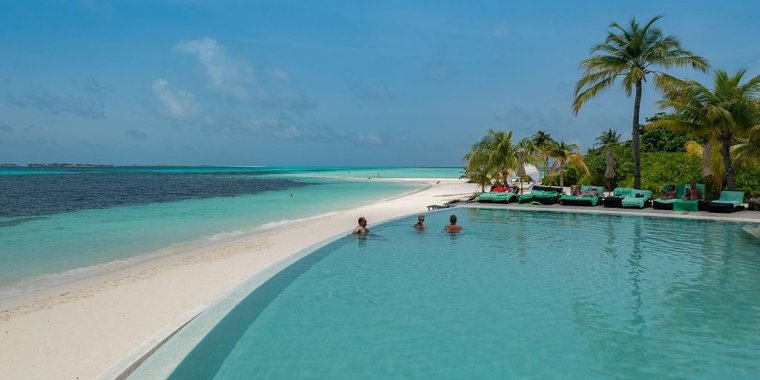
Infinity Pool Malediven Insel. ![]()
YOU MAY ALSO LIKE


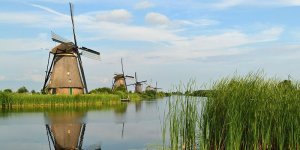
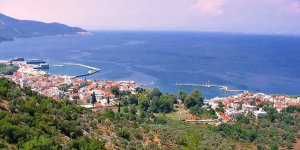
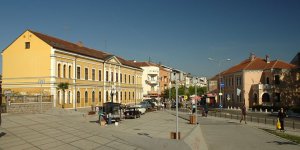
 If you own or manage a travel-related business such as a hotel, a bed-and-breakfast, a restaurant, a pub or a cafeteria, you can create a web page for your business for free on Titi Tudorancea Travel Info. » |
